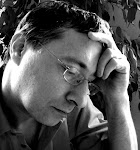My goal is of course to be able to turn off my mind and enjoy the place and the moment. But that takes time for me. I have to slow down gradually. Walking helps. And as I walked, I was thinking about how I would capture the scene in prose and in film, in such a way that it would give an audience the experience of immersion in the woodland.
In prose, the task seems simple enough. First give a 'wide shot' - a general description of the whole place. Throw in some mention of sound, scent or texture. Then home in on progressively smaller detail. A strand of spider silk caught in the sunlight between the trees, for example. The job is done in half a dozen lines.
But I have often puzzled over how I would shoot such a scene in film. The range of light from dark shadow to brilliant splashes of sunlight. The 360 degree, all round above and below experience. The human eye and brain can take it all in. Harder for a camera.
Clearly the film approach would parallel the prose description. Wide shots and close up detail inter cut. The revelation that came to me today - probably obvious to most people - is how much easier it would be to film and edit if there was a person there in some of the shots. A person to turn his or her head, to observe the fine detail and the panoramas so that when we cut to them, there is the implication that we are seeing through that person's eye.

Of course, a person is there in the prose description. The narrator. An implied observer, taking in the detail on our behalf. Perhaps the two forms are not so different after all.








